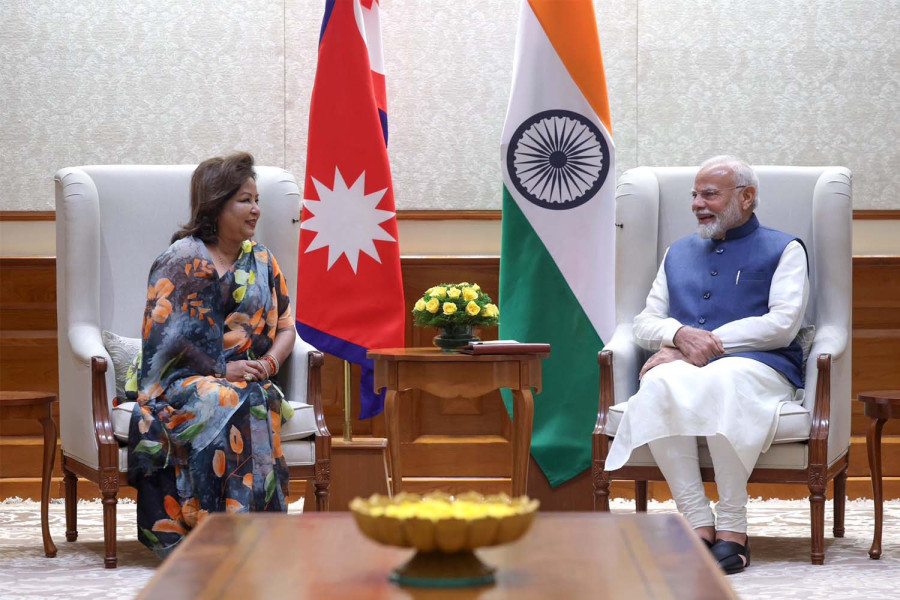Columns
Optics matter
How much of the public’s cynicism about our leaders’ foreign policy initiatives is grounded in reality?
John Narayan Parajuli
Whenever I mention that I’m researching Nepal’s Grand Strategy, the initial reaction I often get—even from well-informed individuals—is one of disbelief. Although they are too polite to say it aloud, I can almost hear them thinking, “Are you out of your mind?”
Many people doubt whether Nepal’s democratic governments of the post-1990 era can formulate a coherent foreign policy, let alone deliberate on a grand strategy. The psychological outlook we’ve inherited as citizens of a country sandwiched between two giants and the chaotic nature of our foreign policy establishment fuel this scepticism. Adding to that is the nostalgia for the finesse and pomp with which the palace once operated. Is there some truth to these perceptions?
The Ministry of Foreign Affairs (MoFA) has been primarily relegated to administrative functions, lacking both intellectual direction and a political mandate from the top leadership. The Nepali Defence Ministry is often jokingly called a “post box.” But has the MoFA’s role dwindled to a little more than passport printing and logistical support for foreign visits?
Our top leaders' overreliance on personal dealings with foreign counterparts—often through non-state intermediaries—continues to tarnish public perception and weaken the foreign policy establishment as a whole. During extreme crises and trust deficits, relying on private individuals or non-state actors as messengers and influencers may be acceptable. However, habitually abusing it undermines state capacity and risks state interest manipulation.
Foreign Minister Arzu Rana Deuba’s visit to India last week elicited scepticism in some quarters. However, the optics of meeting top Indian leaders were hailed by many as proof of a successful visit.
Rana in Delhi
Rana's red-carpet treatment in New Delhi, including a meeting with Indian Prime Minister Narendra Modi, symbolises India’s comfort with the Nepali Congress’ presence in the new ruling coalition. There is no denying that the Nepali Congress is favourably regarded in New Delhi and Washington, which speaks to the party's legacy and ability to communicate with these key partners. Moreover, we cannot misread the hospitality accorded to Rana, a significant Nepali Congress leader and the spouse of the prime minister-in-waiting.
One might assume that Rana carried a message from Prime Minister KP Sharma Oli, assuring New Delhi that Kathmandu seeks to maintain cordial relations and resolve bilateral irritants, including the Kalapani issue and Nepal’s new map, through mutual consultation. However, the pre-departure press release from MoFA was terse, stating that Rana would “discuss matters of mutual interest.” The Indian press release offered more details, mentioning discussions on the “full range of the India-Nepal bilateral partnership,” including progress on power trade and sports cooperation. Later, the Nepali embassy in Delhi made cursory references to various issues, including air routes for Bhairahawa and Pokhara airports.
Many issues need to be resolved: Kalapani, air routes, preferential treatment for Nepali goods, Nepali recruitments in the Indian Army after the Agniveer scheme and the Eminent Persons Group (EPG) report, among others. Despite numerous high-level exchanges annually or with every government change on both sides, the issues regarding perceived security sensitivities have been ring-fenced; there seems to be a tacit agreement between both governments to remain quiet about this matter. Instead, both sides want to oversell the issues of high-voltage optics around development. “Yes, we agreed to add another 200 MW of electricity to an already bright bilateral relationship.”
Deferring discussions on these difficult issues only festers the problem. While Nepal needs to respect India’s genuine security concerns and proactively address them, the latter needs to stop exaggerating its security sensitivities to impede things it doesn’t like.
Overall, the visit was limited mainly to symbolism—a courtesy call to Nepal’s most important partner by a new foreign minister, conveying an invitation from a prime minister perceived as difficult in New Delhi due to his nationalist stance and occasional ‘leanings toward Beijing.’
Initially, the Indian Ministry of External Affairs was comparatively more transparent and offered some substance beyond the vague reference to usual ‘issues of mutual interest.’ Additionally, Indian press reports mentioned that Rana would use the visit for a health check-up.
I don’t believe that Nepali government departments are inherently less transparent than their Indian counterparts. The issue lies in our permanent governments' diminishing involvement in setting the agenda for high-level exchanges, especially with key partners and subsequent public communication. Compared to their Indian counterparts, MoFA officials appear to have less space and autonomy to shape the visit’s agenda.
Politicians caught up in their myopic power struggles can perhaps be forgiven for failing to consider civil service reforms. However, it’s astonishing that no chief secretary has advocated strengthening the permanent government’s strategy in the last decade. Instead, some have tried installing cameras to monitor their colleagues without addressing the root causes of poor performance. So, it is appropriate to question whether the problem lies in the structure, the hiring policies, the pay incentives, the skillsets, or all of the above.
The more politicians and civil servants undermine the role of Nepali institutions, the more the agency of Nepal and Nepalis will diminish, and it will become more favourable for powerful foreign influencers to dictate everything.
Greater transparency, restoration of normal administrative processes and strict adherence to standard operating procedures in diplomatic dealings are the only ways to restore the credibility lost in the public’s eyes. Allowing public cynicism to fester is, in many ways, akin to a self-fulfilling prophecy, as beliefs are as powerful as actual events.




 5.17°C Kathmandu
5.17°C Kathmandu















